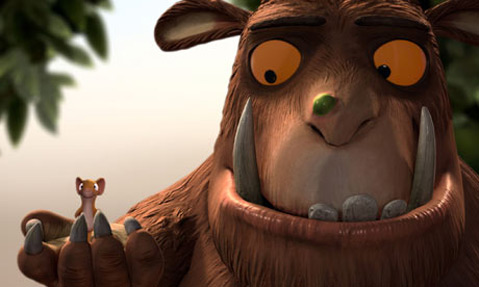The Gruffalo
An Interview with Jakob Schuh

Last Sunday, my wife and I took our 13-month-old son to the Arlington Theatre to experience SBIFF’s AppleBox program, the free admission/free popcorn weekend morning event for families that puts movies built for kids on the big screen. Figuring that our boy’s attention span wouldn’t last a whole film, we decided to try out the shorts program, arriving just in time for the second animated film.
Called The Gruffalo, it follows the exploits of a fearful but crafty mouse on his trek through the forest to find a nut, and features a fox, snake, and owl as his enemies. Our son enjoyed the on-screen animals when he was paying attention — 13 months is indeed a stretch for any length of still sitting time—but like many “children’s movies” before it, The Gruffalo was even a treat for us grown-ups. Luckily, it plays twice more over the weekend for anyone wanting to check it out.
To learn a bit more, the director Jakob Schuh recently answered a few of my questions.
How did you find out about the children’s book?
I was first introduced to The Gruffalo by producer Michael Rose in the summer of 2003. We met in a Café in Annecy and he talked very passionately about a children’s book I’d often seen in bookstores but had never read until then. I bought a French copy the day after our first meeting and worked my way through the French translation which is very, very different from the English original. But I got the idea of it and I liked it a lot.
What made you think this book would be right for a short animated film?
I guess the thing that first struck me about the book was its archaic simplicity. The Gruffalo feels a bit like it’s a very old children’s story you’ve somehow never heard of before. Plus it’s an empowering tale for children, that — although it’s set in quite a dangerous little universe — tells children that they’ll very likely be fine as long as they use their wits, no matter how mouse-like they might feel or be otherwise. Also, the book’s whimsical rhymes are a lot of fun to read to someone, and I was really curious to treat these not as rhymes but as straightforward dialogue.
Were there any major deviations from the book?
With an adaptation, I think it’s always worthwhile to try and understand the core of what people love about the original. In this case the dialogue is a huge part of that, so we decided to stick very closely to that — not an easy feat with five minutes of dialogue for a 30-minute film. But almost any child between one and 12 in the U.K. and Germany knows the text by heart, and they would react very sensitively had we changed a word. So the most obvious deviation was that we had to find an equivalent for the parent that usually reads the book to a child before bedtime. There’s a great narrator’s voice throughout the book and we decided to create a “framestory” about a single squirrel mother conjuring up this story bit-by-bit to calm her kids down for the evening after an unsettling encounter with an owl.
Tell me a little about the animation techniques. Was there anything revolutionary or cutting edge involved? How long did it take to make?
We’re a tiny and comparably young studio, so all in all it took us about two years to make this. In terms of technique, we decided to use physical miniature sets, which we shot without any characters in them and CG-characters that were later composited into the shot footage. The reason for that was that I didn’t want to lose the tactile quality of Axel Scheffler’s original drawings, and with a budget like ours, it would have been very tough to maintain the level of detail and charm that a physical sculpt gives you. If a sculptor’s hand makes a little mistake, it often looks charming; if a computer does, it usually doesn’t.
What’s the usual path for animated shorts? Do they wind up on TV or DVDs or in classrooms?
In the case of children’s films — which is what I do mostly — the films have their times on festivals, then they’re being broadcast, and then they go to DVD. So you have very different audiences throughout this lifecycle.
Assuming there is not a huge commercial market for these films, this must be a labor of love. So why animated films aimed at children? What’s your motivation?
The commercial incentive is an unlikely motivation for children’s films like these, that’s true, but if you sit in a big cinema filled of children — like at the Chicago International Children’s Film Festival last fall — and these kids start to squeal with joy, without any particular gag happening, just out of pure enjoyment, I sometimes wish we could keep this level of involvement in films later in our lives. Hearing these noises is enough reason to make a film every now and then.
4•1•1
Jakob Schuh’s The Gruffalo screens on Saturday, February 5, 10 a.m., and Sunday, February 6, 4 p.m., at the Metro 4. The schedule is subject to change, so see independent.com/sbiff for updates.



